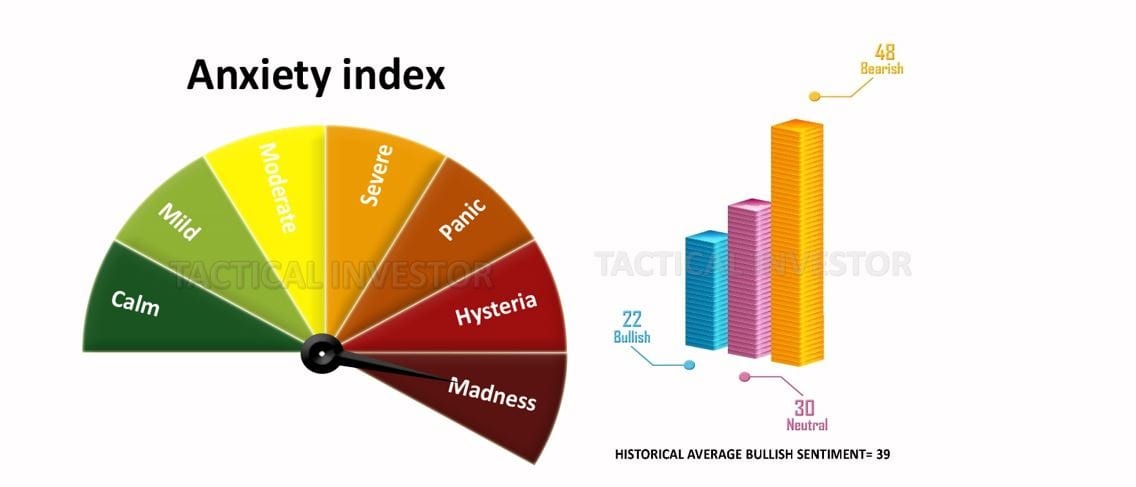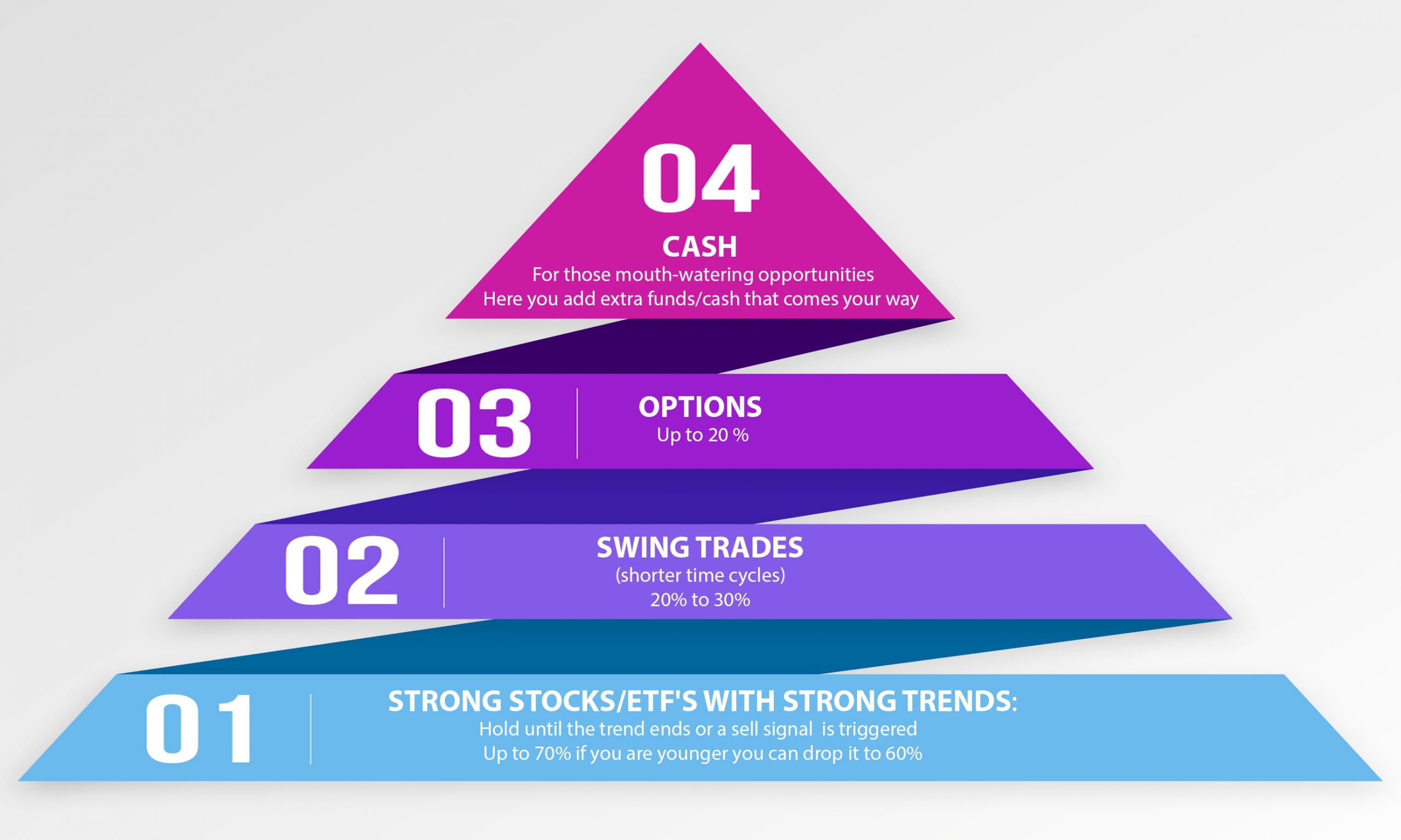
What is an investment pyramid?
Updated April 12, 2024
An investment or risk pyramid is a strategic framework for portfolio allocation based on the risk levels associated with different investments. In this approach, the degree of risk in an investment is characterized by the variance in its potential return or the probability that the investment might significantly decrease in value.
At the foundation of the investment pyramid, we find low-risk investments occupying the broadest segment. These low-risk assets are typically characterized by their stability and minimal fluctuations in value over time. Investors opt for these assets when seeking a secure foundation for their portfolio, aiming to safeguard their capital while generating modest returns.
Moving up the pyramid, the mid-portion is dedicated to growth investments. These investments carry a higher degree of risk compared to low-risk assets but also offer the potential for greater returns. Growth investments often include stocks of established companies exhibiting promising growth prospects or mutual funds focusing on capital appreciation over the long term. While these assets might experience more significant fluctuations, they are favoured by investors with a moderate risk appetite who seek to balance potential gains with a manageable level of risk.
The pyramid’s apex houses speculative investments, representing the smallest allocation in the portfolio. Speculative investments come with substantial risk due to their inherent uncertainty and potential for significant price swings. These could include high-risk startup stocks, volatile commodities, or other assets prone to rapid value changes. Investors who allocate a portion of their portfolio to speculative investments are typically willing to tolerate higher levels of risk in pursuit of potentially substantial rewards.
Examples of investments for each layer of the pyramid
– Low-risk investments: high-quality bonds, treasury securities, and money market funds
– Growth investments: blue-chip stocks, dividend-paying stocks, and index funds
– Speculative investments: penny stocks, cryptocurrencies, and leveraged ETFs
Unlocking Success with the Investment Pyramid: Beyond Structure to Strategic Proficiency
The investment pyramid strategy underscores the importance of diversification. It encourages a well-rounded portfolio that balances risk and potential returns across different asset classes. By intelligently distributing investments across the three layers of the pyramid, investors aim to optimize their risk-reward trade-offs while aligning their investment choices with their financial goals and risk tolerance.
While the structure of the investment pyramid often commands significant attention, it’s crucial to shift the focus toward crafting a robust system for identifying potent stocks within resilient sectors. The essence lies in the pyramid’s arrangement and in honing a methodology to spot emerging stars amidst strong sectors. The key to success lies in investing in stocks on the cusp of a breakout or firmly entrenched in a vigorous uptrend phase, yielding a success rate exceeding 80%. However, fixating solely on the often arbitrary ratios propagated by most investment pyramids without cultivating a well-thought-out strategy could prove disadvantageous in the long-term journey of investment prowess.
Identifying emerging stars and stocks on the cusp of a breakout
– Look for stocks in sectors with strong fundamentals and positive industry trends
– Use technical analysis tools like moving averages, relative strength index (RSI), and volume indicators to spot stocks with bullish momentum
– Examples: a technology stock with innovative products and increasing market share or a healthcare stock benefiting from a new drug approval
Strategic Insights: The Layers of Our Investment Pyramid
Our investment pyramid adheres to simplicity, guiding investors toward prudent allocation of funds. A significant portion is earmarked for robust stocks/ETFs, focusing on maintaining these positions until the trend concludes. At Tactical Investor, we leverage the Trend Indicator to identify emerging trends effectively.
Explanation of the Trend Indicator and its use in identifying emerging trends
– The Trend Indicator is a proprietary tool developed by Tactical Investor that analyzes multiple market factors, such as price action, volume, and sentiment
– It helps identify the overall market trend (bullish, bearish, or neutral) and the strength of that trend
– By using the Trend Indicator, investors can make informed decisions about when to enter or exit positions based on the prevailing market conditions
Between 20% and 30% of your funds should be directed towards swing trades—a strategy distinct from day trading. Unlike the often unfruitful path of day trading, which sees many individuals departing with less than they started, swing trading within our pyramid entails holding positions for 3 to 6 months, optimizing potential gains without incurring unnecessary risk.
Progressing within the pyramid, we encounter options investing, which may surprise us with its potential to yield impressive returns or provide a consistent income stream. The cardinal rule is to cap option investing at 20% of your portfolio, a safeguard against undue exposure. Dividing this portion into 6 to 10 lots, evenly distributed investment sums are allocated to each play.
Approach to options investing within the pyramid strategy
– Focus on high-probability options strategies like covered calls, cash-secured puts, and spreads
– Manage risk by limiting options exposure to a small portion of the portfolio and diversifying across multiple positions
– Continuously monitor options positions and adjust as needed based on market conditions and the underlying stock’s performance
Embracing Strategic Diversification: The Path to Empowered Investment
This principle echoes in stock investment, where the total capital balances are equal. Consider, for instance, dividing $100,000 into ten segments of $10,000. Each element is further subdivided into three lots, enabling staggered investments. This approach offers the chance to acquire the same stock or option at a lower price during potential pullbacks, amplifying reward while mitigating risk.
In essence, our investment pyramid crafts a journey that progresses from the foundational strength of stocks and ETFs, which extends through tactical swing trades, to the strategic realm of options investing. By abiding by this approach, investors harness the power of calculated diversification, ensuring their portfolio thrives on a blend of stability, growth, and strategic potential.
Navigating Market Trends: A Focus Beyond Investment Pyramids
So, where is the market heading? Let’s rewind to our perspective during the March 2020 market crash. In this new paradigm, amidst the prevailing chaos, it’s crucial to recognize that while the investment pyramid concept holds relevance, it’s not the paramount concern. Priority lies in positioning oneself on the right side of the fence before contemplating the application of investment pyramid or risk pyramid strategies.
Well ahead of the pandemic’s emergence, we noted the determined trajectory of central bankers, particularly the Fed, towards driving interest rates to the vicinity of zero. Envision the response if the Fed had orchestrated a 150-basis point rate cut just a fortnight ago—such a move would have triggered a spectrum of reactions. It’s noteworthy that critics hastened to label it as recklessness when the Fed reduced rates before the onslaught of the coronavirus crisis.
However, fast forward to a 150-basis point rate cut in the aftermath of the crisis, and the sentiment shifts to demanding further action. Observe the intricacy of this strategy: to execute actions that the majority resents, a diversion must first be created, capturing their attention. Then, a solution that’s threefold more impactful than the initial problem is introduced. In the wake of their quest for security, individuals are inclined to endorse whichever path is presented, regardless of its true implications.
Revealing Nuances in Market Dynamics: Beyond Investment Structures
This sequence underscores the subtleties within the dynamics of market trends. Beyond investment pyramids, the direction of the market requires astute perception. Economic indicators do not solely dictate the market’s course but are also shaped by intricate moves that influence perceptions, behaviour, and decision-making. Being in alignment with these forces positions an individual to anticipate market trends, navigate shifts, and adapt strategies to capitalize on evolving scenarios.
Market sentiment and the Federal Reserve’s role in the investment pyramid strategy
– Pay attention to market sentiment indicators like the CBOE Volatility Index (VIX) and investor surveys to gauge overall market mood
– Monitor Federal Reserve actions and statements, as they can significantly impact market sentiment and direction
– Adapt the investment pyramid strategy based on prevailing market conditions, potentially shifting allocations between risk levels as sentiment and Fed actions dictate
The system is going to be flooded with so much liquidity that the markets will melt upwards when the media starts to report the data more accurately. Right now, they talk about the mortality rate without breaking the data down and informing the masses that older individuals are the ones that fall into the high-risk category. Even then, most of them appear to have some other complications already. Market Update March 18, 2020
A Frenzy Amidst Uncertainty
Undoubtedly, the current juncture presents one of the most formidable challenges since the onset of the 2008 financial crisis. Hysteria has taken hold, particularly within the U.S., fueling a self-perpetuating frenzy from the highest echelons to the grassroots, leaving everyone in a whirlwind of activity akin to headless chickens.
Everyone at the Tactical Investor is freeing up all the available cash they can. We have spoken of living below one’s means in the past, and we all intend to drop down and live 1 to 2 standards below our means temporarily and direct these savings towards the market. Don’t take this as a sign to throw caution to the wind; we will deploy capital in a disciplined and controlled as we have always advocated. Market Update March 24, 2020
Unlocking Potential: The Power of Bearish Sentiment
Remarkably, bearish sentiment serves as an unexpected catalyst for robust market rallies. We are on the brink of what can be aptly dubbed the “mother of all buy signals.” A minor downward shift is required to align our indicators, poised to activate this pivotal signal and usher in a new wave of opportunity.

We are dangerously close to hitting the upper limit of the madness zone. Remember that before this pandemic, the gauge never even hit the extreme end of the hysteria zone. So, this is an unprecedented development. Given this massive move in the anxiety gauge, neutral readings would now need only to dip down to 10% to trigger the “father of all buy signals” provided our technical indicators move to the extremely oversold ranges and the Trend indicator remains positive (bullish). Market Update March 30, 2020
Our Current Perspective: A Noteworthy Anomaly
What adds an even more astonishing layer to our analysis is a phenomenon that would have been deemed “unimaginable” merely a few months ago. The bullish sentiment, an indicator of a positive market outlook, currently rests below its historical average. Reflect on this moment: while the Nasdaq scales new peaks and the Dow reclaims most of its losses, the bullish sentiment stands at levels typically associated with pronounced market corrections.
In this climate, it becomes paramount to keep meticulous records. Such an approach is the key to deciphering the enigma that lies ahead. The realm we find ourselves in, aptly termed the “market of disorder,” is poised to elicit a sense of bewilderment amongst market participants. When we say “everyone,” we’re referring to those who steadfastly cling to the outdated paradigms of the past (which encompasses a significant 90% of participants). We extend an early warning to all our subscribers, marking the commencement of an era of disarray. Brace yourselves, for the cycle of insanity is upon us, heralding a reality where the unimaginable has the potential to manifest.
Crash Course: Thriving Amid Shifting Market Sentiment
Remember, for most of 2023 and the last few months of 2022, bullish sentiment traded below its historical average of 39. It remained in this range for almost 18 months while the markets drifted higher. This is unprecedented. As Jesse Livermore wisely noted, “The big money is not in the buying and selling but in the waiting.” This aligns perfectly with the idea of embracing strong pullbacks and market crashes until sentiment changes.
John Templeton’s contrarian approach also supports this notion, as he famously stated, “To buy when others are despondently selling and to sell when others are avidly buying requires the greatest fortitude and pays the greatest ultimate rewards.” Investors can position themselves for significant gains by capitalising on market sentiment shifts.
Moreover, Charlie Munger’s emphasis on patience and discipline in investing is crucial during these times. “The big money is not in the buying or the selling, but in the waiting,” he once said. This reinforces the importance of remaining patient and disciplined, even during market crashes, until sentiment shifts in our favour.
Hence, before this market crashes, bullish sentiment will have to trade at elevated levels, at least above 55 if not 60, for several weeks on end before we can state that a long-term top is in place and the markets are ready to crash. Until that occurs, all pullbacks ranging from medium to strong should be embraced. Thriving amid shifting market sentiment requires fortitude, patience, and a willingness to go against the crowd, as demonstrated by the wisdom of Livermore, Templeton, and Munger. End of story.
Unearth Extraordinary Articles for Your Curiosity

The Trap: Why Is Investing in Single Stocks a Bad Idea?

Investment Pyramid: A Paradigm of Value or Risky Hail Mary?

Quantitative Easing: Igniting the Corruption of Corporate America

Uranium Market Outlook: Prospects for a Luminous Growth Trajectory

Stock Investing for Kids: Surefire Path to Success!

An Individual Who Removes the Risk of Losing Money in the Stock Market: A Strategic Approach

Palladium Forecast: Unveiling the Stealth Bull Market

I Keep Losing Money In The Stock Market: Confronting the Stupidity Within

Is Value Investing Dead? Shifting Perspectives for Profit

Analyzing Trends: Stock Market Forecast for the Next 6 Months

Example of Groupthink: Mass Panic Selling at Market Bottom

Contrarian Thinking: The Power of Challenging the Status Quo

Mastering Technical Analysis Of The Financial Markets

Unraveling the Enigma: The Dark Allure of Mob Mentality




